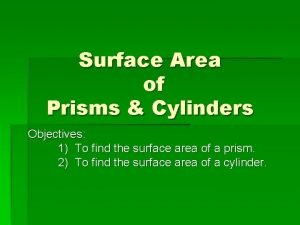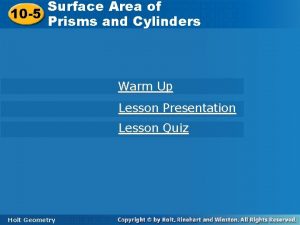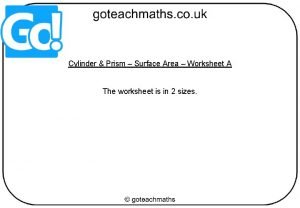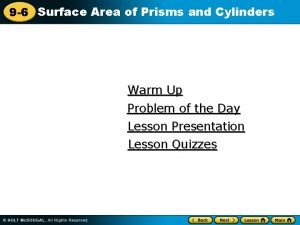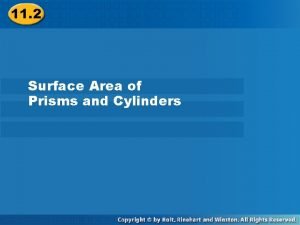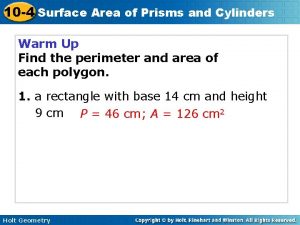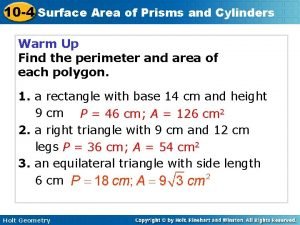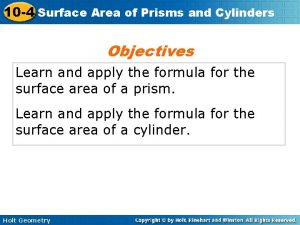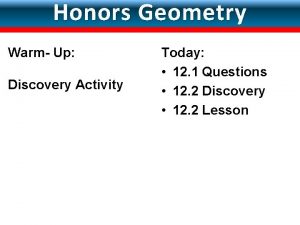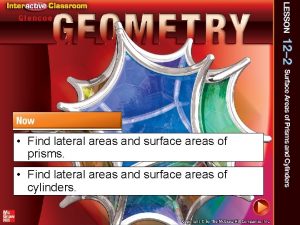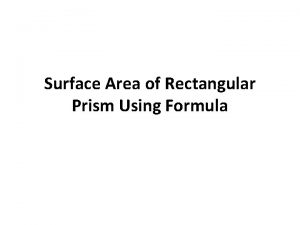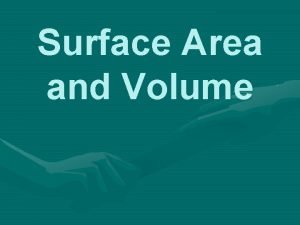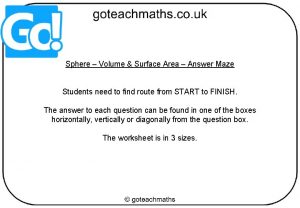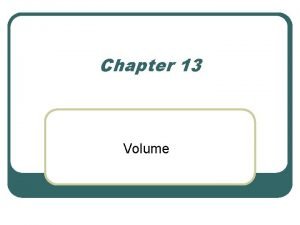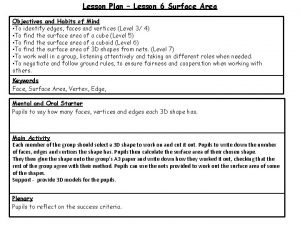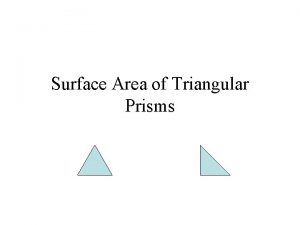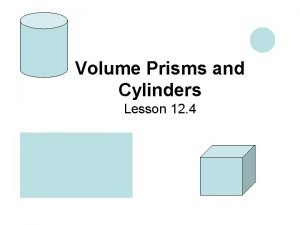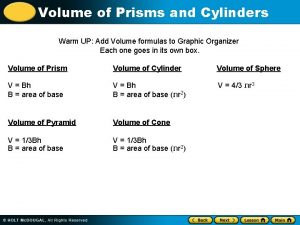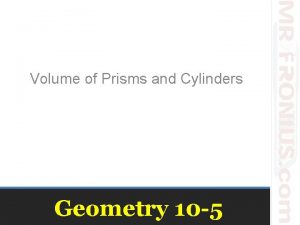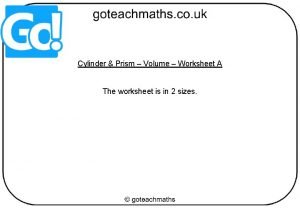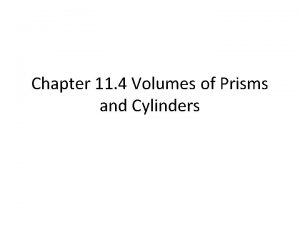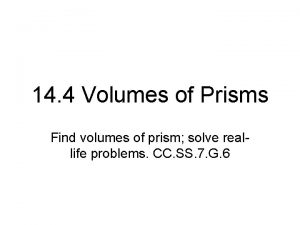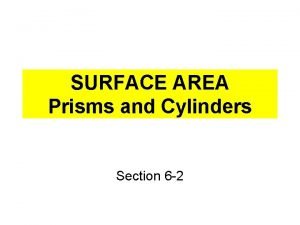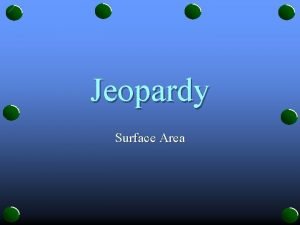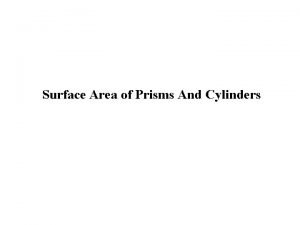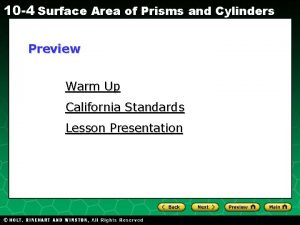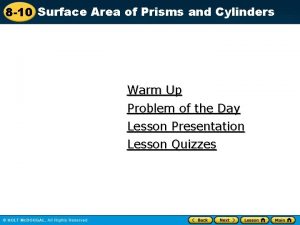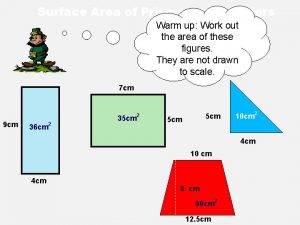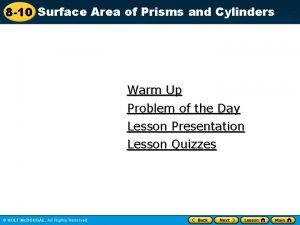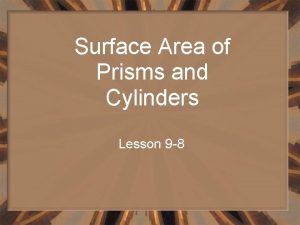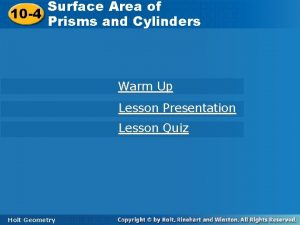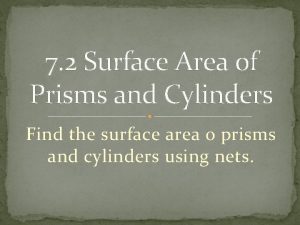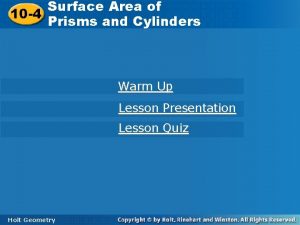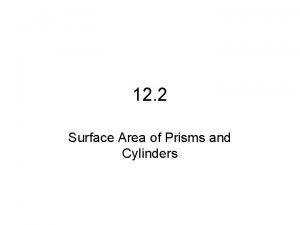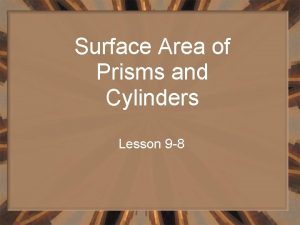Section 10 3 Surface Area Of Prisms Cylinders























- Slides: 23

Section 10 – 3 Surface Area Of Prisms & Cylinders Objective: To find the surface area of a prism To find the surface area of a cylinder

Prism: Prism A polyhedron with exactly two congruent, parallel faces Base: Congruent, parallel faces Lateral Faces: Faces that ARE NOT bases Height of Prism: The length of the altitude that joins the two bases We Name a Prism by the Shape of its Bases

Lateral Area: The sum of the areas of the lateral faces Surface Area: The sum of the lateral area and the area of the two bases

Example 1 Finding Surface Area of a Prism A) Use a net to find the lateral and surface area of the rectangular prism below.

B) Use a net to find the lateral and surface area of the triangular prism below.

C) Use a net to find the lateral and surface area of the cube below.


Theorem 10 – 1 Lateral & Surface Area of Prisms L. A. = ph S. A. = L. A. + 2 B

Example 2 Using Formulas to Find Surface Area A) Use formulas to find the lateral area and surface area of the prism.

B) Use formulas to find the lateral area and surface area of the prism.

C) Find the surface area of a 10 cm high prism with triangular bases having 18 cm edges. Round to the nearest whole number.

HOMEWORK Textbook Page 531 – 532; #1 – 7 All


Section 10 – 3 Continued… Objective: To find the surface area of a cylinder

Cylinder: Cylinder Has two congruent, parallel circle bases Base: Congruent, parallel circle faces Height of Cylinder: The length of the altitude that joins the two bases

Lateral Area: The curved surface between the two bases (when unrolled – it is a rectangle) Surface Area: The sum of the lateral area and the area of the two bases

Theorem 10 – 2 Lateral & Surface Area of Cylinders

Example 3 A) Finding Surface Area of a Cylinder The radius of the base of a cylinder is 4 in. and its height is 6 in. Find the lateral and surface area of the cylinder in terms of π.

B) Find the lateral and surface area of a cylinder with height 10 cm and radius 10 cm in terms of π.

C) The radius of the base of a cylinder is 6 ft, and its height is 9 ft. Find its lateral and surface area in terms of π.

Example 4 Real-World Connection A) The drums of the roller below are cylinders of length 3. 5 ft. The diameter of the drum is 4. 2 ft. What area does the large drum cover in one full turn? Round your answers to the nearest square foot.

B) A company sells cornmeal and barley in cylindrical containers. The diameter of the base of the 6 in. high cornmeal container is 4 in. The diameter of the base of the 4 in. high barley container is 6 in. Which container has the greater surface area?

10 – 3 Ditto; #1 – 15 Odd
 Find the total surface area of the prism
Find the total surface area of the prism Surface area of prisms & cylinders
Surface area of prisms & cylinders Surface area cylinders and prisms worksheet
Surface area cylinders and prisms worksheet Surface area of prisms
Surface area of prisms How to find surface area
How to find surface area Lesson 10-4 surface area of prisms and cylinders
Lesson 10-4 surface area of prisms and cylinders 11-2 practice surface areas of prisms and cylinders
11-2 practice surface areas of prisms and cylinders Lesson 10-4 surface area of prisms and cylinders
Lesson 10-4 surface area of prisms and cylinders 12-2 surface areas of prisms and cylinders
12-2 surface areas of prisms and cylinders Lateral surface area of a prism
Lateral surface area of a prism Formula for surface area of a right triangular prism
Formula for surface area of a right triangular prism Volume and surface area of cone
Volume and surface area of cone Surface area formula rectangular prism
Surface area formula rectangular prism Surface area of prisms
Surface area of prisms Volume of cylinders cones and spheres maze
Volume of cylinders cones and spheres maze Volume of a oblique cylinder
Volume of a oblique cylinder Lesson 6 reteach surface area of prisms answer key
Lesson 6 reteach surface area of prisms answer key Formula for surface area of triangular prism
Formula for surface area of triangular prism Fictional character
Fictional character Volumes of prisms
Volumes of prisms Geometry
Geometry How to find volume of half cylinder
How to find volume of half cylinder 11-4 volumes of prisms and cylinders
11-4 volumes of prisms and cylinders Volume of trapezium
Volume of trapezium
